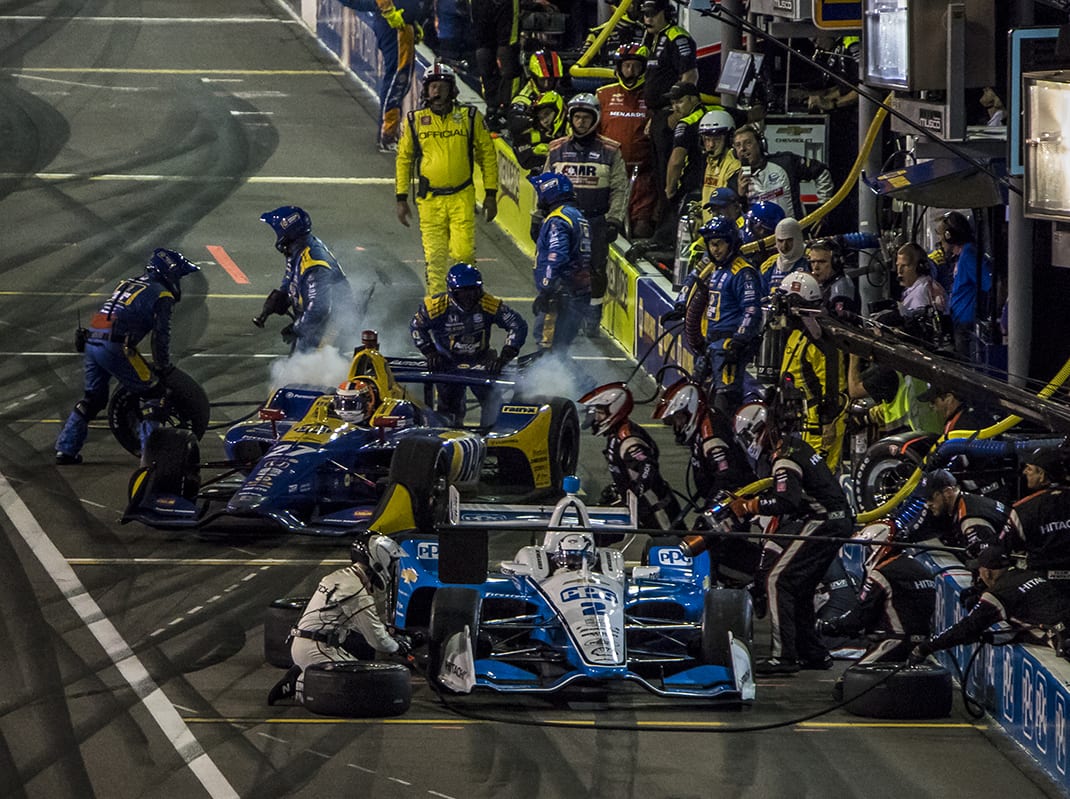The IndyCar pit crew needs to be more versatile, combining engineering and mechanically ability with the athleticism required to do a fast pit stop.
“As the fuel tanks get smaller and you dump in the fuel quicker, now the tire guys have to be faster,” Moyer said. “Back when we were doing 40 gallons, it was a matter of getting the fuel hose plugged in quick enough and that was going to be your pit stop because you were dumping in 12 to 14 seconds worth of fuel. Now, you are dumping six or seven seconds worth of fuel.
“All of a sudden, the tire guys have to be quicker. Your outside guys running around the car have to be more athletic.
“It’s surprising because you see big guys who are 6-foot-2, 200 pounds doing a right rear and you also see some guys 160 pounds light on their feet and they make it up there, but they definitely have to be athletes.”

One thing that is different in IndyCar from NASCAR is the crew chief changes the outside front tire. That way he can see the entire pit stop and has an overview of what else is going on up and down pit road. In NASCAR, the crew chief usually sits on top of the team’s pit box.
“The outside-front guy manages what is going on, on the pit stop,” Lacasse said. “You have strategists and engineers helping you, but ultimately you are in control of the stop, whether you are doing wing or no wing or red tires or black tires and what set you are doing. You try to keep the fueler in tune with how much fuel to put in the car.
“My gearbox guy does the inside-rear tire for us. Our parts guy is the fueler on Simon’s car. This is his first full year doing it. Our rear-end guy is our inside-front-tire changer and our front-end guy is our outside-front-tire changer. Our air jack guy is our truck driver. Everybody on the pit crew has a spot in our shop.”
There are also major differences between an Indy car pit stop and a NASCAR stop. The wheels on an Indy car are attached by one wheel nut. In NASCAR, the wheels are held on by five lug nuts. NASCAR uses manual jacks. In IndyCar, pneumatic jacks are built into the car.
“The one wheel nut makes it a bit quicker,” Moyer said. “You have one guy on each corner. You have the same amount of guys on a NASCAR pit crew as you do in IndyCar, the thing is they only have two wheel guns, the guys carry their tires and we are already set up before the car comes in so that part is quicker for Indy car racing.
“Gun wise, we run the same pressure and same type of guns as everybody else runs, especially in sports car racing,” Moyer added.” The biggest thing with sports car racing is they only allow two guys and two guys change all the tires, so they have to do all the work, but the fuel has to flow in 30 seconds. You can’t go any faster than 30 seconds on a tank of fuel, so they have plenty of time to change the tires.
“In IndyCar, it’s about five to six seconds to do the tires and six or seven seconds on a full tank of fuel. The air jack guy doesn’t have to be that strong; what he has to do is be really quick with good hand-eye coordination to hit the hole with the air hose.”
Each crew member must possess ample amounts of bravery because they are constantly in harm’s way.
“Is it dangerous? Yes,” Moyer said. “But we used to do it without pit lane speeds. Guys were flying behind you at Indianapolis going 125 or 150 mph. We didn’t have helmets on. There weren’t the penalties then that you have now. The brakes weren’t as good as on these cars.
“It’s still very, very dangerous the way it is now, but it’s a lot safer. IndyCar has done a great job with safety.”
